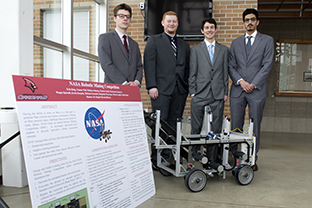May 14, 2018
SVSU engineering students take on new challenge, design Mars robot for NASA competition
 A team of 12 senior engineering and computer science students at Saginaw Valley State University have designed a robot prototype that would be capable of mining a simulated surface of the planet Mars. Next week, they will see how their design stacks up against the nation’s best.
A team of 12 senior engineering and computer science students at Saginaw Valley State University have designed a robot prototype that would be capable of mining a simulated surface of the planet Mars. Next week, they will see how their design stacks up against the nation’s best.
NASA will host its ninth annual Robotics Mining Competition at the Kennedy Space Center in Florida May 14-18. This is the first year SVSU students will be among the 55 U.S. colleges and universities to compete.
The SVSU Robotics Club tested their creative and problem-solving abilities over the past year. Electrical engineering students took the reins on building the mechanical and electrical system for the robot while computer science students involved worked on the navigation system for the robot.
“We wanted the project to challenge us,” said Connor Peil, an electrical engineering major from Bay City. “The ability to mine on Mars is a useful resource to help in understanding that terrain. That's the first step to any sort of future colonization - making sure you're even adaptable. That's mainly what our project overviews.”
A year in the making, the robot employs the belt-mining method in which buckets attached to the belt are rotated in order to continuously dig up material. Equipped with situational-awareness sensors, the robot is capable of navigating a simulated Mars-like surface.
The students worked closely with Rajani Muraleedharan, associate professor of electrical and computer engineering and advisor to the SVSU Robotics Club. She empowered students across majors to participate in the design and construction of the robot.
To qualify for the contest, Muraleedharan and the team put together a technical paper detailing their ideas for the project and how those ideas would be executed. A video demonstration of the prototype was also submitted.
“The purpose of the competition is to try to utilize universities and student minds to come up with new technology ideas,” said Eric King, an electrical engineering major from Woodhaven. “In a way, NASA is outsourcing the ideas in order to find what works best.”
The competition will ask teams to mine gravel which simulates the icy rocky material found on the surface of Mars. A $5,000 scholarship will be offered as the grand prize during the competition with several other prizes available.
“Ultimately, what they're looking for is design ideas,” King said. “There can be a winner but they might not necessarily have the technology that transfers to what NASA would use so it's really about innovation - you're trying to get NASA to consider a design that you came up with.”
The team was assisted by several donors including StoneQuest; Joel Kiss, SVSU assistant director of campus facilities; the SVSU Foundation; the SVSU Electrical and Computer Engineer Department; Frank Hall, dean of the College of Science Engineering & Technology; Darlene Seegert, administrative secretary; as well as a number of other supporters.
For more information about the NASA Robotics Mining Competition, visit www.nasa.gov/offices/education/centers/kennedy/technology/nasarmc.html.
